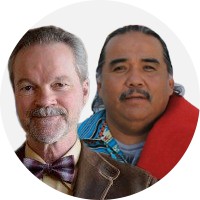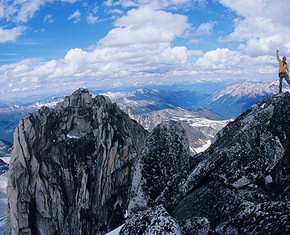The views expressed in our content reflect individual perspectives and do not represent the authoritative views of the Baha'i Faith.
The Baha’i teachings say that the Bab and Baha’u’llah, the twin holy messengers who heralded and founded the Baha’i Faith, represent the return of the prophets of the past:
Contemplate with thine inward eye the chain of successive Revelations … I testify before God that each one of these Manifestations hath been sent down through the operation of the Divine Will and Purpose, that each hath been the bearer of a specific Message, that each hath been entrusted with a divinely-revealed Book and been commissioned to unravel the mysteries of a mighty Tablet. The measure of the Revelation with which every one of them hath been identified had been definitely fore-ordained. – Baha’u’llah, Gleanings from the Writings of Baha’u’llah, pp. 74-75.
With the primary Baha’i principle of progressive revelation in mind, this series of Chris Buck’s interviews with Navajo Baha’i Bitahnii Wayne Wilson continues to explore the close relationship between Navajo and Baha’i beliefs.
Q: Greetings again, Bitahnii Wayne! So what can you tell us from your perspective as a Navajo Baha’i about the relationship between “Talking God” and Baha’u’llah, and “Calling God” and the Bab?
A: As a Navajo, my understanding of the relationship between them goes deep. For Navajos, the station of Talking God represents the beginning of a new day, dawn’s early light, the beginning of springtime and on into summer time. Calling God represents the ending process of the day, being the evening twilight. He represents the fall, and, from the season of autumn, on into winter.
Both have a special station. They represent the duality within nature, within the male essences of our Grand Father, our father, Universal Father Sky, the sun and the female essences of our Grand Mother, our mother, Mother Earth, and the moon. They balance and complement one another. They are the ones that teach us to live in Hozho (balance and harmony) within oneself and all existence.
They, too, tell us to live a virtuous lifestyle. During the Nine Night Ceremony, Talking God and Calling God appear throughout: one is at the front of the male and female dancers, and one is at the tail end. As they dance, they teach by their dancing of the cycles in everything. They teach of the many cycles of change, and the many attributes of the Great Spirit.
As a Navajo, I see the same teachings of the Bab and Baha’u’llah within these Holy Grand Fathers. Talking God sacrificed his voice for us humans to be able to speak and have a voice. I see and experience a similar, if not the same thing, happening as a result of the Baha’i revelation. Now that we were given the right to speak in the beginning of the development of humanity, today we are given all of the voices of the Holy Prophets of God, whose words, in their sacred writings and prayers, have developed with humanity to elevate and reach our spiritual capacity. The Talking God Chant, to some extent, asks us to aspire to goodness, to holiness, to spirituality:
Talking God Prayer
In Kininaekai
In the house made of dawn.
In the story made of dawn.
On the trail of dawn.
O, Talking God!
His feet, my feet, restore [or: heal]
His limbs, my limbs, restore.
His body, my body, restore
His mind, my mind, restore
His voice, my voice, restore
His plumes, my plumes, restore
With beauty before him, with beauty before me
With beauty behind him, with beauty behind me
With beauty below him, with beauty below me
With beauty above him, with beauty above me
With beauty around him, with beauty around me
With pollen beautiful in his voice, with pollen beautiful in my voice.
It is finished in beauty.
It is finished in beauty.
If you look at this prayer carefully as a Navajo, it tells a story of a sacred and Holy Place where there is a White House in the East, where the sun rises: “In the house made of dawn. In the story made of dawn. On the trail of dawn.” This, too, tells me of a spiritual place. To me, as a traditional Navajo, I know that there is a special meaning within this prayer chant, because it tells us, with reassurance, of this sacred place. Now I’m sure that when Talking God made and gave us this prayer, he was telling his Grand Children and the future generations of this place in some way. It is a message to the future about this Sacred and Holy Threshold, that, we as Baha’is, know of this place that some say is the Holy Land, or Haifa, Israel.
Saying “O, Talking God!” would be like Baha’is praying (by paraphrasing this sacred Navajo prayer chant): “O, Baha’u’llah! Thy feet, my feet, restore [or: heal]. Thy limbs, my limbs, heal. Thy body, my body, heal. Thy mind, my mind, heal. Thy voice, my voice, heal. Thy plumes, my plumes, restore.”
Q: For me, this brings to mind one of Baha’u’llah’s prayers for healing, the “Long Healing Prayer,” said to be endowed with a special power:
I call on Thee O Most Sublime One, O Beauteous One, O Bounteous One! Thou the Sufficing, Thou the Healing, Thou the Abiding, O Thou Abiding One! . . .
I call on Thee O Magnificent One, O Ancient of Days, O Magnanimous One! Thou the Sufficing, Thou the Healing, Thou the Abiding, O Thou Abiding One! . . .
I call on Thee O Greatest Remembrance, O Noblest Name, O Most Ancient Way! Thou the Sufficing, Thou the Healing, Thou the Abiding, O Thou Abiding One! . . .
I call on Thee O Friend, O Physician, O Captivating One! Thou the Sufficing, Thou the Healing, Thou the Abiding, O Thou Abiding One!
I call on Thee O Glory, O Beauty, O Bountiful One! Thou the Sufficing, Thou the Healing, Thou the Abiding, O Thou Abiding One!
I call on Thee O the Most Trusted, O the Best Lover, O Lord of the Dawn! Thou the Sufficing, Thou the Healing, Thou the Abiding, O Thou Abiding One!
I call on Thee O Enkindler, O Brightener, O Bringer of Delight! Thou the Sufficing, Thou the Healing, Thou the Abiding, O Thou Abiding One! . . .
O Sufficer, I call on Thee, O Sufficer!
O Healer, I call on Thee, O Healer!
O Abider, I call on Thee, O Abider!
Thou the Ever-Abiding, O Thou Abiding One! – Baha’u’llah, Baha’i Prayers, pp. 90-98.
I can see, Bitahnii Wayne, that you emphasize the spiritual harmony of Talking God and Baha’u’llah, and the beauty of their teachings – and how, through Baha’u’llah’s revelation, we voice and universalize the teachings of Talking God.
The most important Navajo prophecy of Baha’u’llah is the harmony with the teachings of Talking God, as enshrined in the sacred Navajo prayer chants. We can think of those chants as sacred scriptures in oral form, a living tradition spiritually confirmed, complemented, and completed by the teachings of Baha’u’llah, the voice of Talking God for this day and age.
















Comments
Sign in or create an account
Continue with Googleor